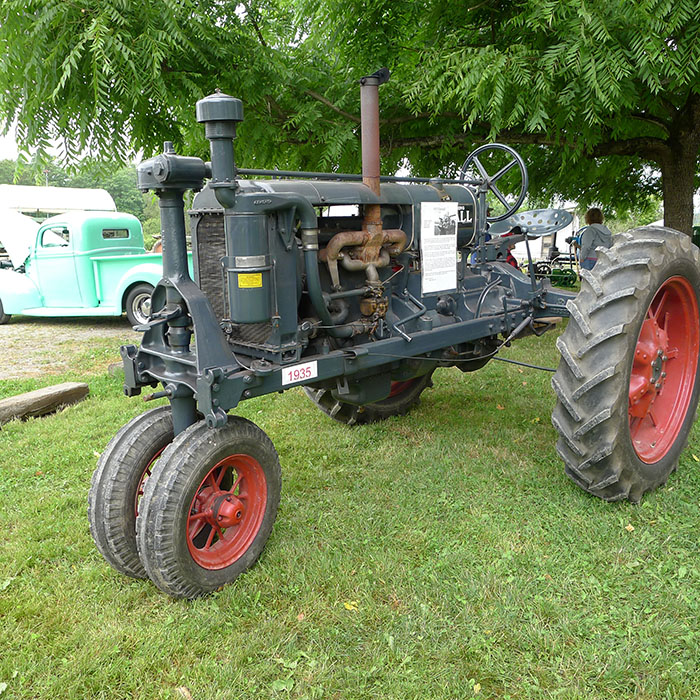Tractor Paint Colors
/When dark and rainy November arrives, nothing feels nicer than sitting down in your cozy home with the latest issue of Antique Power magazine, guaranteed to offer plenty of brightly colored tractors among those featured. If published back in the late 1800s and early years of the 20th century, however, Antique Power might have looked more like the November landscape outside your window than the artist’s palette it resembles today. It seems most tractors in that era were painted drab colors, such as dark green, charcoal, black, brown, or gray, perhaps with some bright accents. The history of paint schemes on tractors is a colorful story, even if it did not start out that way.
During my research, I ran across interesting theories as to why gray, for example, seemed to dominate, ranging from the use of military surplus paint to the color’s ability to hide pigeon poop. (Yes, you read that right!) I choose to withhold comment on these ideas and (without any actual proof) suggest that the color gray’s association with industry and machinery probably made it seem like a logical choice. Also, dark neutrals might simply have been popular. Early automobiles, some home decor fabrics, and even women’s fashions reflected a taste for these colors during the turn of the last century. Interestingly, the first truly colorful tractors appeared about the time of the Great Depression. Just as those economically grim years were the heyday for upbeat jazz bands, movies, and dancing, so, too, did the apparent need for cheer manifest in tractor paint. Builders no doubt hoped the appeal of brighter colors would translate into bigger sales.
Allis-Chalmers helped start the trend when the company’s paint choice changed from the green used since 1914 to the now-famous “Persian Orange.” These days, we all think of Farmall tractors as being red, but they were still painted gray for about a decade after Allis-Chalmers made the bold move to orange. Farmall did stick a timid toe into a new paint can as early as 1930, however, when the paint committee decided the drawbar should be red. By 1937, red covered the entire tractor. Fords remained gray until the late 1940s, when the company introduced the new red/gray color scheme on the 8N. Later, Fords appeared painted blue with gray. Oliver moved away from the old Hart-Parr-type dark green to a lighter shade by the mid thirties. In 1939, Case dropped its old gray paint for a hue with the exotic name of “Flambeau Red.”
Reasons for color changes included safety, as when industrial tractors switched to yellow, and a desire on the part of manufacturers to distinguish themselves from their competitors. These days, people would say these companies were “branding” themselves. Mergers also initiated new color schemes. This was the situation when Massey-Harris went from gray to red with yellow wheels in the late 1930s, followed by the introduction of a red-with-gray scheme during the 1950s, after Harry Ferguson Inc. merged with Massey-Harris to become known as Massey-Ferguson. Sometimes, multiple and combined mergers led to tractor genealogies as messy as families with too many “kissing cousins.” Those cases added confusion to decisions about paint.
Manufacturers often changed the shade of the paint even while staying within the same hue. Olivers did not keep one shade of green forever, just as Minneapolis-Moline used different golds. John Deere collectors can tell you about the “Classic Green” of the 2-cylinder models and “Agricultural Green” on the “New Generation” Deeres.
Seasoned collectors and restorers love to debate the topic of tractor colors and their correctness, a subject newbies would be wise to challenge them on. Considering all the changes that occurred, it is never safe to make assumptions about proper paint color. If you want to be sure your restoration is historically correct, use the serial number to do some careful research concerning exactly what paint was used when. The luckiest restorers are those who, while tearing a tractor apart, find a bit of well-preserved original paint in a hidden spot. Even then, however, factors like age, heat, and other conditions might have altered it. To further complicate the situation, even modern commercial paint colors identified with tractor brand names, sounding very official, might not be exactly right. They can vary from one manufacturer to another, or one batch to another, and may not take into consideration the changes in shade that occurred over a certain make’s lifetime.
So what is a tractor owner to do? Even if you painstakingly choose the perfect color, nothing on this earth is permanent. Realize that, one day, someone else with his own ideas will probably own that tractor and redo all your work. In the big picture, others before you made decisions about paint, and you have the same right to make your own, historically correct or otherwise. Accuracy matters a great deal to many people and less to others. I cannot say for sure, but perhaps the happiest people are those who can relax enough to just enjoy their tractors—red, green, purple, or pink— as much as they enjoy the eye-candy in an issue of Antique Power on a rainy November night.
To learn more on this topic, including serious advice on the actual process of painting, I highly recommend one of several sources I used for this post, a book by Tharran Gaines, titled How to Restore Your Farm Tractor. It is available in the Ertel Gift Shop.
Now, pour yourself a fresh cup of coffee, and sit down with Antique Power to enjoy all those pictures of pretty tractors with a new perspective on how they came to be.
If you can't find Antique Power on a newsstand near you, call 800-767-5828 or visit our Gift Shop to order current or back issues. To subscribe, call 888-760-8108 or click here.








